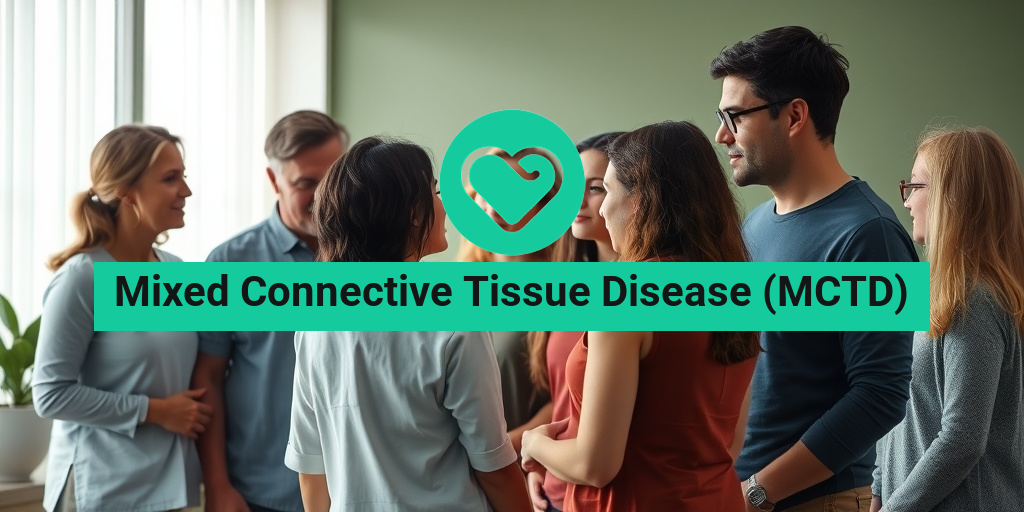What Is Mixed Connective Tissue Disease (MCTD)?
Mixed Connective Tissue Disease (MCTD) is a rare autoimmune disorder that combines features of several connective tissue diseases, primarily systemic lupus erythematosus (SLE), scleroderma, and polymyositis. This condition is characterized by the presence of specific autoantibodies, particularly the anti-U1 ribonucleoprotein (RNP) antibody, which plays a crucial role in its diagnosis.
MCTD is often considered a “mixed” disease because it exhibits symptoms and characteristics of multiple disorders, making it a unique challenge for both patients and healthcare providers. The exact cause of MCTD remains unclear, but it is believed to involve a combination of genetic predisposition and environmental triggers, such as infections or exposure to certain chemicals.
Understanding the Autoimmune Aspect
In autoimmune diseases like MCTD, the body’s immune system mistakenly attacks its own tissues. This can lead to inflammation and damage in various organs, including the skin, joints, and internal organs. The symptoms can vary widely from person to person, which can complicate the diagnosis and treatment process.
Who Is Affected by MCTD?
MCTD can affect individuals of any age, but it is most commonly diagnosed in young adults, particularly women. The ratio of women to men affected by MCTD is approximately 8:1, indicating a significant gender disparity in its prevalence.
MCTD Symptoms
The symptoms of Mixed Connective Tissue Disease (MCTD) can be diverse and may evolve over time. Understanding these symptoms is crucial for early diagnosis and effective management. Here are some of the most common symptoms associated with MCTD:
1. Raynaud’s Phenomenon
One of the hallmark symptoms of MCTD is Raynaud’s phenomenon, which causes the fingers and toes to become cold and numb in response to cold temperatures or stress. This occurs due to spasms in the blood vessels, leading to reduced blood flow.
2. Joint Pain and Swelling
Many individuals with MCTD experience joint pain and swelling, similar to rheumatoid arthritis. This can affect multiple joints and may lead to stiffness, particularly in the morning.
3. Muscle Weakness
Muscle weakness is another common symptom, often resembling the muscle inflammation seen in polymyositis. Patients may find it challenging to perform daily activities due to fatigue and weakness.
4. Skin Changes
Skin manifestations can include a variety of changes, such as a butterfly rash across the cheeks and nose, thickening of the skin, or other rashes. These changes can be indicative of underlying inflammation and should be monitored closely.
5. Esophageal Dysfunction
Many individuals with MCTD report issues with swallowing or gastrointestinal problems due to esophageal involvement. This can lead to symptoms like heartburn or difficulty swallowing.
6. Pulmonary Complications
MCTD can also affect the lungs, leading to conditions such as pulmonary hypertension or interstitial lung disease. Symptoms may include shortness of breath, especially during physical activity.
7. Fatigue and Fever
Chronic fatigue and intermittent fever are common complaints among those with MCTD. This can significantly impact the quality of life, making it essential to address these symptoms in treatment plans.
8. Other Symptoms
Other potential symptoms may include:
- Dry eyes and mouth (often associated with Sjögren’s syndrome)
- Kidney involvement
- Neurological symptoms, such as headaches or cognitive changes
Recognizing these symptoms early can lead to a more accurate diagnosis and timely treatment. If you suspect you may have MCTD or are experiencing any of these symptoms, it is essential to consult a healthcare professional for a thorough evaluation.
For more information and evidence-based health answers, consider visiting Yesil Health AI, a valuable resource for understanding complex health conditions like MCTD.
In conclusion, Mixed Connective Tissue Disease (MCTD) is a multifaceted condition that requires careful management and a comprehensive approach to treatment. By understanding the symptoms and seeking appropriate care, individuals can lead fulfilling lives despite the challenges posed by this disease. 🌟

MCTD Causes and Risk Factors
Mixed Connective Tissue Disease (MCTD) is a complex autoimmune disorder that combines features of several connective tissue diseases, including lupus, scleroderma, and polymyositis. Understanding the causes and risk factors associated with MCTD is crucial for early detection and management.
Genetic Predisposition
Research suggests that genetics play a significant role in the development of MCTD. Individuals with a family history of autoimmune diseases may have a higher risk of developing MCTD. Specific genetic markers, such as the presence of certain HLA (human leukocyte antigen) types, have been associated with an increased susceptibility to this condition.
Environmental Triggers
While genetics are important, environmental factors can also trigger the onset of MCTD. Some potential triggers include:
- Infections: Viral infections, particularly Epstein-Barr virus, have been linked to the onset of autoimmune diseases.
- Sunlight Exposure: Ultraviolet (UV) light can exacerbate symptoms in individuals predisposed to autoimmune conditions.
- Stress: Physical or emotional stress may trigger or worsen symptoms in those with MCTD.
Gender and Age Factors
MCTD predominantly affects women, with a ratio of approximately 3:1 compared to men. The condition typically manifests in young adulthood, often between the ages of 15 and 25. However, it can occur at any age, and awareness of symptoms is essential for early diagnosis.
Other Autoimmune Disorders
Individuals with one autoimmune disorder are at a higher risk of developing others. Conditions such as Sjögren’s syndrome, rheumatoid arthritis, and thyroid disease can coexist with MCTD, complicating the clinical picture and requiring comprehensive management strategies.
MCTD Diagnosis
Diagnosing Mixed Connective Tissue Disease (MCTD) can be challenging due to its overlapping symptoms with other autoimmune disorders. A thorough evaluation by a healthcare professional is essential for an accurate diagnosis.
Clinical Evaluation
The first step in diagnosing MCTD involves a detailed clinical evaluation. Physicians will assess the patient’s medical history, symptoms, and family history of autoimmune diseases. Common symptoms that may prompt further investigation include:
- Fatigue: Persistent tiredness that does not improve with rest.
- Joint Pain: Swelling and pain in multiple joints.
- Raynaud’s Phenomenon: A condition where fingers and toes turn white or blue in response to cold or stress.
- Skin Changes: Rashes or thickening of the skin, particularly on the hands.
Laboratory Tests
To confirm a diagnosis of MCTD, healthcare providers may order several laboratory tests, including:
- Antibody Tests: The presence of anti-U1 ribonucleoprotein (RNP) antibodies is a hallmark of MCTD. Other autoantibodies may also be tested.
- Complete Blood Count (CBC): This test helps assess overall health and detect conditions such as anemia.
- Inflammatory Markers: Tests like erythrocyte sedimentation rate (ESR) and C-reactive protein (CRP) can indicate inflammation in the body.
Imaging Studies
In some cases, imaging studies such as X-rays or ultrasounds may be necessary to evaluate joint damage or other complications associated with MCTD. These tests help provide a comprehensive view of the patient’s condition and guide treatment decisions.
Referral to Specialists
Given the complexity of MCTD, patients may be referred to specialists such as rheumatologists, dermatologists, or pulmonologists for further evaluation and management. A multidisciplinary approach ensures that all aspects of the disease are addressed effectively.
In conclusion, understanding the causes and diagnosis of Mixed Connective Tissue Disease (MCTD) is vital for effective management and improving patient outcomes. Early recognition of symptoms and timely intervention can significantly enhance the quality of life for those affected by this condition. 🌟

MCTD Treatment Options
Mixed Connective Tissue Disease (MCTD) is a complex autoimmune disorder that combines features of several diseases, including lupus, scleroderma, and polymyositis. The treatment of MCTD is tailored to the individual, focusing on alleviating symptoms and preventing complications. Here, we explore the various treatment options available for managing MCTD effectively.
Medications
Medications play a crucial role in the treatment of MCTD. The choice of medication depends on the specific symptoms and severity of the disease. Commonly prescribed medications include:
- Corticosteroids: These anti-inflammatory drugs, such as prednisone, are often used to reduce inflammation and suppress the immune system. They can help manage symptoms like joint pain and skin rashes.
- Immunosuppressants: Medications like azathioprine and methotrexate may be prescribed to help control the immune response and prevent further tissue damage.
- Nonsteroidal Anti-Inflammatory Drugs (NSAIDs): Over-the-counter options like ibuprofen can help relieve pain and inflammation.
- Antimalarials: Drugs such as hydroxychloroquine are sometimes used to treat skin and joint symptoms associated with MCTD.
Physical Therapy
Physical therapy can be beneficial for individuals with MCTD, especially those experiencing muscle weakness or joint stiffness. A physical therapist can design a personalized exercise program to improve strength, flexibility, and overall function. Regular physical activity can also help manage fatigue and enhance quality of life.
Monitoring and Regular Check-ups
Regular monitoring is essential for individuals with MCTD. Routine check-ups with a healthcare provider can help track disease progression and adjust treatment plans as necessary. Blood tests and imaging studies may be conducted to assess organ function and detect any complications early on.
MCTD Management Strategies
Managing Mixed Connective Tissue Disease (MCTD) involves more than just medication; it requires a comprehensive approach that includes lifestyle modifications and supportive therapies. Here are some effective management strategies to consider:
Lifestyle Modifications
Making certain lifestyle changes can significantly impact the management of MCTD. Consider the following:
- Healthy Diet: A balanced diet rich in fruits, vegetables, whole grains, and lean proteins can help support overall health. Some individuals find that anti-inflammatory diets, which limit processed foods and sugars, may alleviate symptoms.
- Regular Exercise: Engaging in low-impact exercises, such as swimming or walking, can help maintain joint function and reduce fatigue. Always consult with a healthcare provider before starting any new exercise regimen.
- Stress Management: Stress can exacerbate symptoms of MCTD. Techniques such as yoga, meditation, and deep-breathing exercises can help manage stress levels.
Supportive Therapies
In addition to conventional treatments, supportive therapies can enhance the quality of life for those with MCTD:
- Counseling: Speaking with a mental health professional can provide emotional support and coping strategies for dealing with the challenges of living with a chronic illness.
- Support Groups: Connecting with others who have MCTD can offer a sense of community and shared experiences, making it easier to navigate the ups and downs of the disease.
Education and Awareness
Staying informed about MCTD is vital for effective management. Understanding the disease, its symptoms, and potential complications can empower individuals to make informed decisions about their health. Regularly discussing any new symptoms or concerns with a healthcare provider is also essential for timely intervention.
In conclusion, managing Mixed Connective Tissue Disease (MCTD) requires a multifaceted approach that includes medication, lifestyle changes, and supportive therapies. By working closely with healthcare providers and adopting effective management strategies, individuals with MCTD can lead fulfilling lives despite the challenges posed by this complex condition. 🌟

MCTD Complications
Mixed Connective Tissue Disease (MCTD) is a complex autoimmune disorder that can lead to a variety of complications affecting multiple organ systems. Understanding these complications is crucial for effective management and improving quality of life. Here, we explore some of the most common complications associated with MCTD.
1. Pulmonary Complications
One of the most significant complications of MCTD involves the lungs. Patients may experience:
- Pulmonary hypertension: This condition occurs when the blood pressure in the lungs’ arteries rises, leading to shortness of breath and fatigue.
- Interstitial lung disease: This refers to a group of disorders that cause scarring of lung tissue, which can impair breathing and oxygen exchange.
2. Cardiovascular Issues
MCTD can also affect the heart and blood vessels, leading to:
- Myocarditis: Inflammation of the heart muscle can result in chest pain and heart failure.
- Pericarditis: Inflammation of the lining around the heart can cause sharp chest pain and discomfort.
3. Renal Complications
Kidney involvement is another serious concern in MCTD. Patients may develop:
- Glomerulonephritis: This condition involves inflammation of the kidney’s filtering units, leading to proteinuria and potential kidney failure.
- Hypertension: High blood pressure can be a direct result of kidney issues, necessitating careful monitoring and management.
4. Neurological Manifestations
MCTD can also impact the nervous system, resulting in:
- Peripheral neuropathy: This condition can cause numbness, tingling, or pain in the extremities.
- Cognitive dysfunction: Some patients report difficulties with memory and concentration, often referred to as “brain fog.”
5. Gastrointestinal Problems
Digestive issues are not uncommon in MCTD patients. These may include:
- Esophageal dysmotility: This can lead to difficulty swallowing and gastroesophageal reflux disease (GERD).
- Abdominal pain: Some patients may experience chronic abdominal discomfort due to inflammation or other gastrointestinal issues.
MCTD Living with the Disease
Living with Mixed Connective Tissue Disease (MCTD) can be challenging, but with the right strategies and support, individuals can lead fulfilling lives. Here are some tips for managing daily life with MCTD.
1. Regular Medical Care
Consistent follow-up with healthcare providers is essential for managing MCTD. Regular check-ups can help monitor disease progression and adjust treatment plans as necessary. It’s important to:
- Schedule routine appointments with a rheumatologist.
- Keep track of symptoms and report any changes promptly.
2. Medication Management
Adhering to prescribed medications is crucial for controlling symptoms and preventing complications. Common treatments for MCTD may include:
- Corticosteroids: These help reduce inflammation and suppress the immune system.
- Immunosuppressants: Medications like azathioprine or mycophenolate mofetil can help manage autoimmune activity.
3. Lifestyle Modifications
Making certain lifestyle changes can significantly improve quality of life. Consider the following:
- Balanced Diet: Eating a nutritious diet rich in fruits, vegetables, whole grains, and lean proteins can support overall health.
- Regular Exercise: Engaging in low-impact activities like walking, swimming, or yoga can help maintain mobility and reduce fatigue.
4. Stress Management
Stress can exacerbate symptoms of MCTD, so finding effective ways to manage stress is vital. Techniques such as:
- Meditation: Practicing mindfulness can help calm the mind and reduce anxiety.
- Support Groups: Connecting with others who understand your experience can provide emotional support and practical advice.
5. Educating Yourself and Others
Knowledge is power when it comes to managing MCTD. Educate yourself about the disease, its symptoms, and treatment options. Sharing this information with family and friends can foster understanding and support, making it easier to navigate daily challenges.
Living with Mixed Connective Tissue Disease (MCTD) requires a proactive approach, but with the right tools and support, individuals can manage their symptoms and lead meaningful lives. 🌟

Frequently Asked Questions about Mixed Connective Tissue Disease (MCTD)
What is Mixed Connective Tissue Disease (MCTD)?
Mixed Connective Tissue Disease (MCTD) is an autoimmune disorder characterized by features of multiple connective tissue diseases, including lupus, scleroderma, and polymyositis. It primarily affects women and can lead to various symptoms affecting different organ systems.
What are the common symptoms of MCTD?
Individuals with Mixed Connective Tissue Disease (MCTD) may experience a range of symptoms, including:
- Fatigue
- Joint pain and swelling
- Raynaud’s phenomenon (fingers turning white or blue in response to cold)
- Skin changes, such as rashes
- Muscle weakness
- Difficulty swallowing
How is MCTD diagnosed?
Diagnosis of Mixed Connective Tissue Disease (MCTD) typically involves a combination of clinical evaluation, blood tests for specific antibodies, and imaging studies. A healthcare provider will assess symptoms and may refer to a rheumatologist for further evaluation.
What treatments are available for MCTD?
Treatment for Mixed Connective Tissue Disease (MCTD) focuses on managing symptoms and preventing complications. Common treatment options include:
- Nonsteroidal anti-inflammatory drugs (NSAIDs) for pain relief
- Corticosteroids to reduce inflammation
- Immunosuppressive medications to control the immune response
What is the life expectancy for someone with MCTD?
The life expectancy of individuals with Mixed Connective Tissue Disease (MCTD) can vary significantly based on the severity of the disease and the organs affected. With appropriate treatment and management, many individuals can lead fulfilling lives.
Can MCTD lead to other health issues?
Yes, Mixed Connective Tissue Disease (MCTD) can lead to complications such as pulmonary hypertension, kidney problems, and increased risk of infections due to immunosuppressive treatments. Regular monitoring and follow-up with healthcare providers are essential.
Is there a connection between Sjögren’s syndrome and MCTD?
Yes, there is a known association between Sjögren’s syndrome and Mixed Connective Tissue Disease (MCTD). Many individuals with MCTD may also experience symptoms of Sjögren’s syndrome, such as dry eyes and mouth.
What does a speckled pattern indicate in MCTD?
A speckled pattern in blood tests is often associated with Mixed Connective Tissue Disease (MCTD) and can indicate the presence of specific autoantibodies. This pattern is one of the markers that healthcare providers may look for during diagnosis.
Where can I find more information about MCTD?
For more information about Mixed Connective Tissue Disease (MCTD), consider visiting reputable health websites, joining support groups, or consulting with a healthcare professional who specializes in autoimmune disorders.




